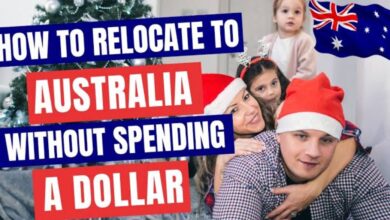How to Get Married to a Canadian Citizen and get a Visa Sponsorship and Secure your Accommodation Before Relocating
So, you’ve found the love of your life in Canada and you’re thinking, “Okay, how do I make this official and actually move there?” That’s exciting, but just like you must have heard, the process of getting married, securing that visa sponsorship, and sorting out accommodation before you pack your bags isn’t exactly a walk in the park. Canadian spousal visa rules can be confusing, and one small mistake could mean delays or even rejection. Imagine planning your future together, only to face visa refusal because you missed a document or got the financial requirements wrong. Or worse, you finally get your visa, but you have nowhere to stay once you arrive. Stressful, right? That’s why you need a solid plan to avoid those headaches. But don’t worry, we wrote this article just for you and we would be walking you through the process step-by-step, like a friend would. So, keep reading till the end.
What is a Canadian Spouse Visa?
A Canadian spouse visa, also known as a spousal sponsorship visa, lets you move to Canada to live with your partner permanently. But this is only if your partner is a Canadian citizen or a permanent resident. Sounds so simple, right? Well, not exactly. If your partner is a permanent resident, they need to be living in Canada to sponsor you. But if they’re a Canadian citizen, they can sponsor you even if they’re living outside of Canada. Just so you know, both of you need to meet certain eligibility requirements to get that sponsorship approved. However, if your partner lives in Quebec, there’s an extra layer of provincial rules to deal with. Fortunately, if you have kids, the spousal sponsorship application can cover them too and even your dependents’ kids.
Before we continue, let’s first understand the different forms of relationships that relate to the Canadian Spousal Sponsorship.
1. Spouse: You’re legally married to your partner. So here, we are talking rings, vows, the whole deal.
2. Common-law Partner: You’ve been living together like a married couple for at least a year. Both of you share the same house, shared bills, and all that good stuff.
3. Conjugal Partner: You’ve been in a serious, committed relationship for at least a year, but you haven’t been able to live together or get married because of things like cultural, political, or religious issues. Basically, life got in the way, but Canada gets it and they made provision for you too.
Canadian Spousal Sponsorship Inland vs Outland
The Spousal Sponsorship Program has two main routes, depending on where you and your partner are living:
1. Family Class Sponsorship (Outland Sponsorship):
Go for this one if your partner is outside Canada or if they’re in Canada but don’t plan on sticking around for the whole application process. Canada is quite flexible here, so your spouse can still apply for a Temporary Resident Visa (TRV) or an Electronic Travel Authorization (ETA) to visit while the sponsorship is being processed. But just so you are in the know, they’ll need to convince the immigration officer that they’ll follow the rules and return if needed. So, make sure their story is convincing.
2. In Canada Sponsorship Class (Inland Sponsorship):
This is for couples already living together in Canada. Even if your partner’s visa status has lapsed, they might still qualify thanks to a special policy that lets them stay while the application is being processed. Just remember, if you go this route, your partner shouldn’t leave Canada until the process is done because leaving could mess things up.
Who is Eligible for a Spouse Visa in Canada?
Let’s break the Canadian spousal visa requirements into three categories, so you can understand them:
Who Can Sponsor
You can sponsor someone if you’re at least 18, a Canadian citizen, a permanent resident living in Canada, or registered under the Canadian Indian Act. If you’re a citizen living outside Canada, you’ll need to show that you plan to return once your partner or child becomes a permanent resident. Permanent residents living outside Canada can’t sponsor anyone. Also, you can’t be on social assistance (unless it’s for a disability), and you’ll need to prove you can support yourself, your spouse or partner, and any dependent children. There’s usually no income requirement unless your partner’s dependent child has their own child. Also, Quebec has its own rules, so you’ll need to meet those too.
Who You Can Sponsor
You can sponsor your spouse, common-law partner, conjugal partner (all at least 18), or your dependent child. But, know that background, security, and medical checks are required.
What are the Canadian Spouse Visa Requirements?
Now, let’s talk about the Canadian spousal sponsorship checklist so you can know which documents to include in your application.
What the Sponsor Needs to Submit
Sponsors must provide completed sponsorship application forms, proof of payment for government fees, and proof of Canadian citizenship or permanent resident status.
What the Sponsored Person Needs to Submit
The sponsored person must submit permanent residence application forms, proof of status (if applicable), identity and travel documents, civil status documents (including for any children), police clearances from any country lived in for six months or more since turning 18, military records (if applicable), a digital photo, and a medical certificate. Additional documents may be required based on personal circumstances.
What Both Must Submit
Both parties need to complete a Relationship Information and Sponsorship Evaluation form and provide proof of any previous relationship dissolutions. If living together, they must submit at least two joint documents like property ownership, rental agreements, utility accounts, joint bank accounts, or government-issued IDs showing the same address. Common-law partners must provide proof of cohabitation for at least a year (e.g., 12 months of joint bank statements).
If Not Living Together
You’ll need to provide proof of contact (texts, emails, letters) and visits (boarding passes, tickets). If you can’t live together or marry (for conjugal relationships), include a written explanation, photos from the last 12 months, proof of financial support, and recognition from family and friends. If some documents are missing, explain why and provide supporting letters or declarations, the more proof you provide, the better your chances.
Before you go ahead and apply, confirm on the official website for the checklist that applies to your specific situation.
Canada Visa Spousal Sponsorship Timeline
It usually takes about 12 months to sponsor your spouse or partner to Canada, but it can vary. If you’re applying through Quebec, it might take up to 25 months since Quebec has its own process. However, a lot of factors can delay the process even more and this includes which province you plan to live in, any missing documents, or even criminal and medical checks.
Canadian Spousal Sponsorship Application Guide
Just so you know, this application is done online. If your sponsor can’t apply online, they can download, print, and complete the form manually.
1. First, your sponsor must visit the Immigration, Refugees and Citizenship Canada (IRCC) website to get the application package. This includes forms, instructions, and checklists.
2. Your sponsor will choose if you’re their spouse, common-law, or conjugal partner and list all the countries you’ve lived in. They’ll fill out Form IMM 5289 and sign it electronically. You’ll also need to sign it because missing signatures automatically mean delays.
3. The sponsor needs to upload all required documents which should include specific documents for each country.
4. You must have your own application profile for permanent residence after completing this step. Each dependent who is 18 years or older needs to complete their own application forms.
5. Make sure you list all your relatives on your application even if they will stay behind because omitting anyone now could lead to problems later.
6. The system will notify you about the upcoming biometric capture and medical examination process after you submit your application. You along with all your dependents need to appear at these sessions.
7. When the IRCC demands an interview, they will provide you with essential information about the date and location.
8. The interview marks the beginning of a waiting period until further notice from IRCC. IRCC will provide a Confirmation of Permanent Residence (COPR) document together with a visa if required when your application is approved.
Bear in mind that Canadian permanent residents who are already present in the country will receive instructions to schedule a landing appointment during which officials will verify all information. The border officer will verify your COPR details and ask several questions when you enter Canada with this document. The confirmation process ends when IRCC verifies all details and you become a permanent resident. If any, the immigration authorities will also provide the reason for their denial of your application. The reason for refusal may allow you to file an appeal or reapply at a later time.
Is There an Interview for Spousal Sponsorship in Canada?
The Canadian spousal sponsorship interview is basically Canada’s way of double-checking that your relationship is real and not just a fast track to permanent residency. They want to be sure you and your partner are genuinely in love and not just trying to scam the system.
Why You Might Be Called for an Interview
Not everyone gets called for an interview, but if you do, it’s usually for one of these reasons:
- If there’s any conflicting info between your forms and supporting documents, they’ll want to clear that up face-to-face.
- If you’ve got an interesting backstory like previous marriages, quick engagements, or a relationship rollercoaster, just expect some extra questions.
- If there are not enough photos, messages, or proof that you’ve actually been together, they’ll want to dig deeper.
What They’ll Ask
During the interview, you and your partner will face questions about things like how you met, the proposal, wedding details, your daily life, future plans, and how you connect with each other’s families. They’re looking for consistency, so make sure your stories line up.
How Much Money Do You Need to Sponsor a Spouse in Canada?
Good news! You don’t need to meet a minimum income requirement to sponsor your partner under the spousal sponsorship program. But (there’s always a but), you will need to prove that you can support your partner’s basic needs once they’re in Canada. That’s because you’ll have to sign an undertaking agreement, which is basically a promise that you’ll have their back financially.
So, while you don’t need to hit a specific income threshold, the immigration officer might still want to see proof that you’ve got the means to support your partner. Think bank statements, employment letters, or any steady source of income, whatever shows you can handle the financial side of things once your partner arrives.
How Long Does It Take to Get Permanent Residency in Canada After Marriage?
Once you’re married, the wait for permanent residency through spousal sponsorship is usually around 10 to 12 months, give or take. Processing times can vary depending on how complete your application is and any personal factors involved as we mentioned earlier. You just have to make sure you’ve got all your documents in order from the start to avoid any delays.
What are the Benefits of Marrying a Canadian Citizen?
If you already feel like giving up because of how complex you think the process is, hang in there. The biggest perk of marrying a Canadian citizen and following up with your application is that you don’t have to stress about proving you have enough money to qualify. Your spouse basically takes on that responsibility when they sponsor you. So, your application won’t get rejected because of your job status or income. Canada’s goal with this program isn’t to find the most skilled worker but it’s more about keeping families together.
How to Secure Accommodation in Canada
Don’t rush to look for long-term accommodation before arriving in Canada because pictures can be deceiving, and you’ll want to personally check out the neighbourhood and get a feel for the area. You can start with short-term accommodation for a few weeks, check out different neighbourhoods, and make sure it fits your lifestyle and budget before committing any funds. It’s easier to avoid lease penalties and future regrets when you’ve seen the place yourself. But, here’s what you can do after a while in Canada:
1. Research the neighbourhood and make sure the area is safe and convenient, with easy access to work, public transport, and essential services.
2. Factor in rent, utilities, and hidden costs like parking and maintenance in a set budget to avoid surprises.
3. When you have seen a property you like, carefully read the lease to know about rent increases, maintenance duties, and any modification limits.
4. Familiarize yourself with tenant rights in your province to avoid future disputes.
5. Inspect the property, check for damages and have the landlord acknowledge them in writing before signing.
6. Ask around and talk to current or past tenants to get a real feel for the place and landlord.
If the space ticks all your boxes, then you can move in.
Conclusion
Planning for a Canada spouse visa and accommodation takes effort, but understanding the process makes it easier. Just make sure your relationship meets Canadian immigration requirements, gather the necessary documents, and meet the necessary criteria to boost your chances of success. Once the visa is approved, you can focus on finding a comfortable place to settle in.





